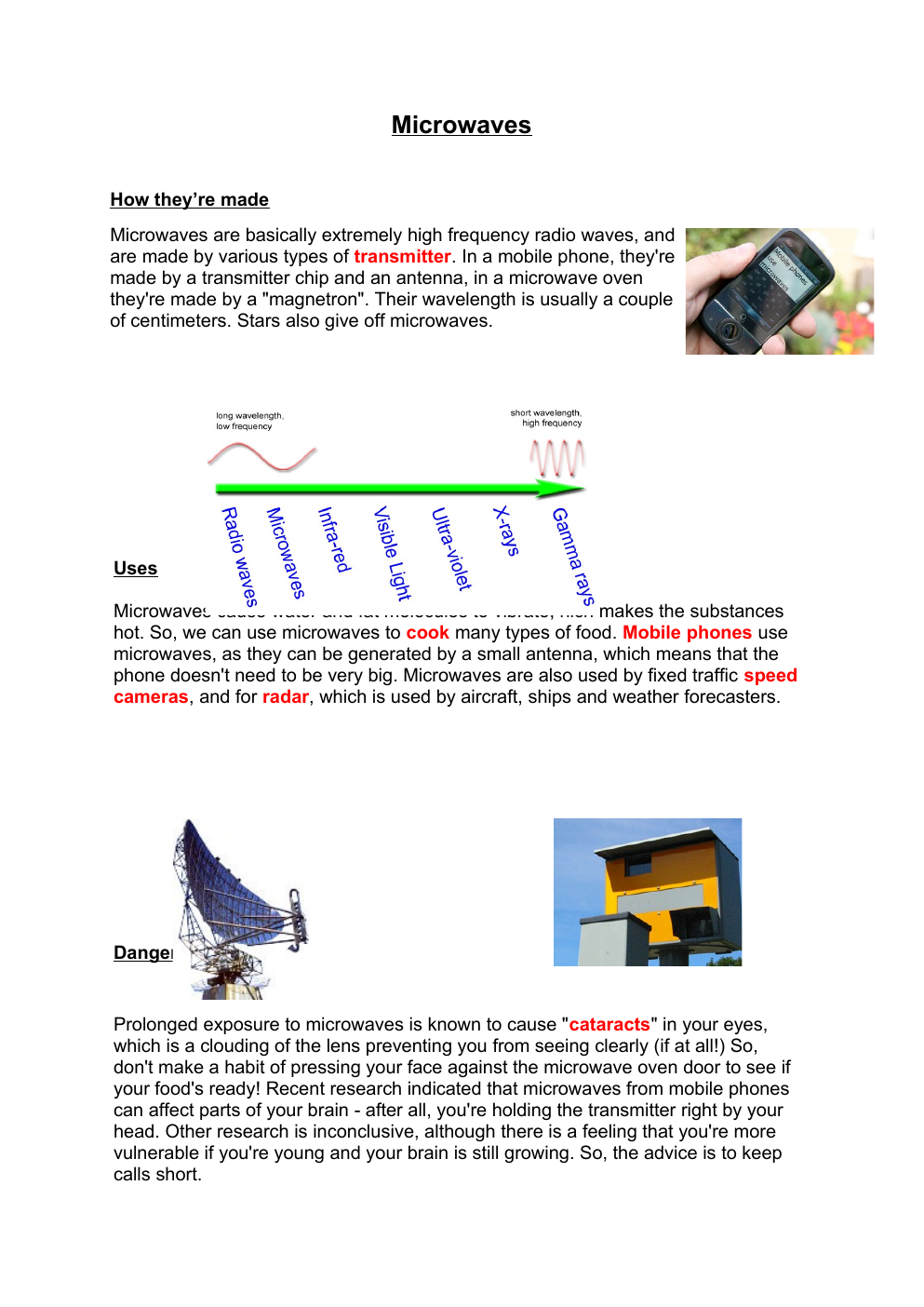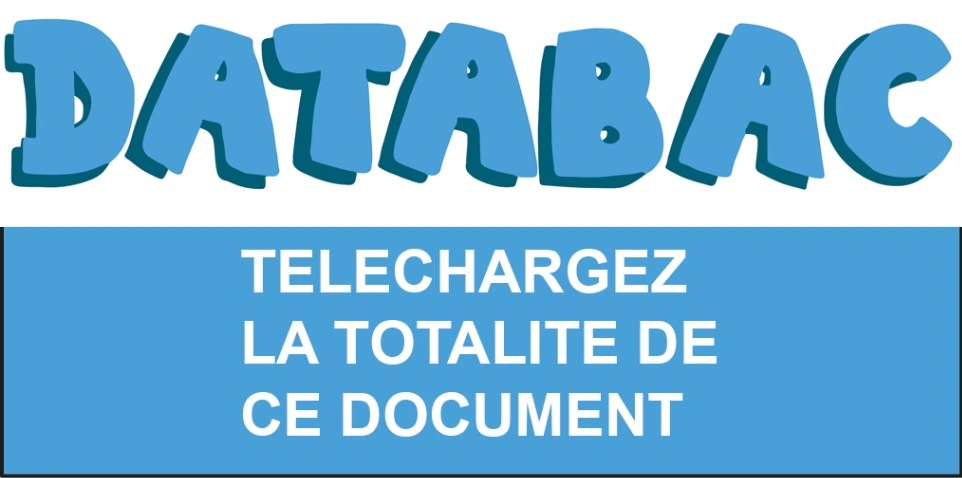MICROWAVES
Publié le 21/11/2022
Extrait du document
«
Microwaves
How they’re made
Microwaves are basically extremely high frequency radio waves, and
are made by various types of transmitter.
In a mobile phone, they're
made by a transmitter chip and an antenna, in a microwave oven
they're made by a "magnetron".
Their wavelength is usually a couple
of centimeters.
Stars also give off microwaves.
Uses
Uses
Microwaves cause water and fat molecules to vibrate, hich makes the substances
hot.
So, we can use microwaves to cook many types of food.
Mobile phones use
microwaves, as they can be generated by a small antenna, which means that the
phone doesn't need to be very big.
Microwaves are also used by fixed traffic speed
cameras, and for radar, which is used by aircraft, ships and weather forecasters.
Dangers
Dangers
Prolonged exposure to microwaves is known to cause "cataracts" in your eyes,
which is a clouding of the lens preventing you from seeing clearly (if at all!) So,
don't make a habit of pressing your face against the microwave oven door to see if
your food's ready! Recent research indicated that microwaves from mobile phones
can affect parts of your brain - after all, you're holding the transmitter right by your
head.
Other research is inconclusive, although there is a feeling that you're more
vulnerable if you're young and your brain is still growing.
So, the advice is to keep
calls short.
Micro-ondes
Comment ils sont fabriqués
Les micro-ondes sont essentiellement des ondes radio à très haute
fréquence
et sont fabriquées par différents types
d’émetteurs.
Dans un téléphone mobile,
ils sont
fabriqués par une puce émettrice et une antenne, dans un four à
micro-ondes, ils sont fabriqués par un « magnétron ».
Leur longueur
d’onde est généralement de quelques centimètres.
Les étoiles émettent
également des micro-ondes.
Utilise
Les micro-ondes font vibrer les molécules d’eau et de graisse, ce qui
rend les substances chaudes.
Ainsi, nous pouvons utiliser des microondes pour cuire de nombreux types d’aliments.
Les téléphones
mobiles utilisent des micro-ondes, car ils peuvent être générés par une
petite antenne, ce qui signifie que le téléphone n’a pas besoin d’être très
grand.
Les micro-ondes sont également utilisées par les radars fixes et
pour le radar, qui est utilisé par les avions, les navires et les
prévisionnistes météorologiques.
Dangers
Dangers
Une exposition prolongée aux micro-ondes est connue pour causer des
« cataractes » dans vos yeux, ce qui est une opacification de la lentille
vous empêchant de voir clairement (voire pas du tout!) Alors, ne prenez
pas l’habitude de presser votre visage contre la porte du four à microondes pour voir si vos aliments sont prêts! Des recherches récentes ont
indiqué que les micro-ondes des téléphones mobiles peuvent affecter des
parties de votre cerveau - après tout, vous tenez l’émetteur juste à côté
de votre tête.
D’autres recherches ne sont pas concluantes, bien qu’il y
ait un sentiment que vous êtes plus vulnérable si vous êtes jeune et que
votre cerveau est encore en croissance.
Donc, le conseil est de garder
les appels courts.
1°) Introduction
Durée : 1 mn 2 mn
This video/text is
cartoon,…
:
a report, an interview, a documentary,….
extracted from TV news,…
a text, a drawing, a photo, a picture, a
It dates from… It was published in…, It comes from…
It consists of…, It’s composed of…, It shows…, represents…,
focuses…, illustrate…, highlights, It deals with…, the main topic is…,
The scene takes place in…
The document entitled…,
2°) Développement
Durée : 4 mn 6 mn
Résumer chacune des parties en reprenant des éléments faire des
périphrases pour redire les idées.
Mieux vaut faire plusieurs petites phrases courtes et simples, plutôt que de
très longues phrases compliquées et hasardeuses.
Rajouter des petits mots de liaisons pour enrichir votre intervention : first,
then, finally,…
3°) Conclusion
Durée : 1 mn 2 mn
Dire ce que l’on retire du document, ce que l’on pense,
Ouvrir vers un thème que l’on maîtrise.
To conclude…, In conclusion…, As a conclusion…,
In my opinion…, according to me…, I think that…, I/I don’t agree with…,
Hello, today I’m going to present you the first document for the BAC of the year
“Microwaves”
The document untitled “Microwaves” that I’m going to present, talks about as its
name suggests from microwaves.
It’s divided in three visible parts accompany by
4 pictures in order to image the words of this text: the first part is How they're
made, the second part is the uses of microwaves and the third part is the
dangers of microwaves.
Firstly, to be able to better understand the document, I will explain what is a
wave? and what is an electromagnetic wave? because microwaves are part of it.
First of all, the most important, what is a wave? We call wave the transfer from
one point to another.
There is two type of wave, the mechanical and nonmechanical waves, and with the microwaves, we are going to talk about the
second one.
Also known as "electromagnetic waves" they do not require a medium for the
transfer of their energy to occur, they are the only type of non-mechanical
waves.
Now that you know that, let's get back to the text
The text focuses mainly on the essentials of the microwaves and the 4 most
frequent uses of this wave, that is to say, antennas, microwaves oven, mobile
phones and fixed radars.
The images accompanying the text are also a photo of
each of....
»
↓↓↓ APERÇU DU DOCUMENT ↓↓↓

































